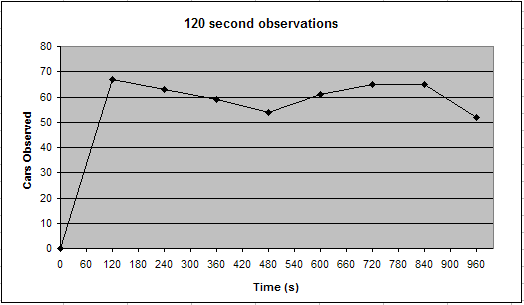 |
AUGUST 2013

On a lazy summer day one may wonder if there is any rhyme or reason to the randomness of cars passing by on the street. In this experiment scientific AmeriKen seeks a scientific viewpoint that can seek out possible patterns. By exploring the possible patterns Scientific AmeriKen hopes not only to find that such a pattern exist but also demonstrate that discovery of the pattern may also completely depend on the viewpoint of the observer.

City traffic is composed of a collection of free willed individuals constrained to the shortest route between A and B. Stop lights, bridges, accidents, pedestrians, emergency vehicles and multitudes of other impediments stand in the way of drivers, yet through this complexity, it is the hypothesis of Scientific AmeriKen that a pattern exist.

Materials include pen and paper, stop watch and a city street, a park bench is recommended. A light post was utilized as a crossing point and the number of cars passing the post was recorded in 10 second increments. Data was then reanalyzed by combining total cars for 10 second increments into 20 second, 30 second, 60 second and 120 second increments.

The data was collected along Indian Creek Dr near 63rd street in Miami Beach, Florida on a Sunday afternoon. Data was collected in 10 second increments and then combined to make 20s, 30s, 60s and 120s increments as indicated below. Total time of collection was nearly 20 minutes and was ceased due to draw bridge activity.




These data support the hypothesis and a pattern was observed, but only when viewing at 20 or 30 second intervals. These data suggest traffic picks up roughly every two minutes at this site. Further detail is also noticed with 30 second observations, but not 20 second, in that the traffic comes in 3 nearly equal intensity waves with the 4th wave having only half of the intensity - although this may purely be a coincidence as additional confirming evidence was cut off by the opening of a draw bridge. The cause of the patterns is open to speculation but most likely due to stop light activity up the road. In conclusion, this experiment provides a unique look into traffic patterns but more importantly reaffirms the importance of experimental design in uncovering patterns.
|
 |
|










